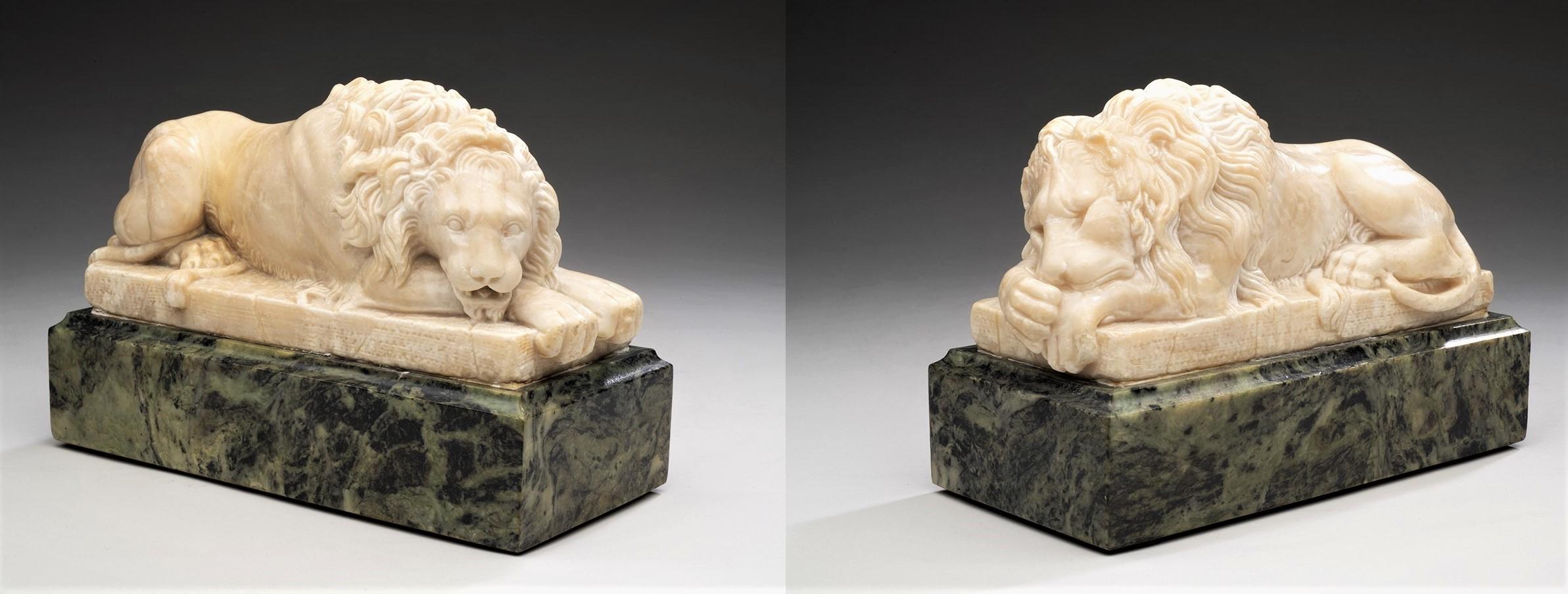Items Similar to ANCIENT ROMAN ALABASTER BUST OF THE GOD SERAPIS, ROME CIRCA 1ST-2ND CENTURY A.D.
Want more images or videos?
Request additional images or videos from the seller
1 of 2
UnknownANCIENT ROMAN ALABASTER BUST OF THE GOD SERAPIS, ROME CIRCA 1ST-2ND CENTURY A.D.Circa 1st-2nd Century A.D
Circa 1st-2nd Century A.D
About the Item
Wearing a chiton with a himation draped at the left shoulder, and a modius on the crown of his head, the god's characteristic luxuriant wavy hair falling in ringlets onto his forehead and down his back, the thick beard centrally-parted and falling in tiers of drilled curls, the face finely carved
- Creation Year:Circa 1st-2nd Century A.D
- Dimensions:Height: 7.29 in (18.5 cm)Width: 1.97 in (5 cm)
- Medium:
- Period:
- Condition:
- Gallery Location:Milan, IT
- Reference Number:1stDibs: LU154428551172
About the Seller
5.0
Vetted Seller
These experienced sellers undergo a comprehensive evaluation by our team of in-house experts.
Established in 2020
1stDibs seller since 2021
6 sales on 1stDibs
- ShippingRetrieving quote...Ships From: London, United Kingdom
- Return PolicyA return for this item may be initiated within 14 days of delivery.
More From This SellerView All
- MONUMENTAL NEOCLASSICAL URN IN ALABASTER -Italy, 19th Century Alabastro fioritoLocated in Milan, ITMONUMENTAL NEOCLASSICAL URN IN ALABASTER Italy, 19th Century Alabastro fiorito 54 x 18 cm 21 1/4 x 7 in minor chips and damagesCategory
19th Century Figurative Sculptures
MaterialsAlabaster
- ITALIAN MARBLE FIGURE OF A GRIFFIN, 19th CenturyLocated in Milan, ITITALIAN MARBLE FIGURE OF A GRIFFIN Italy, early 19th Century marble 87 x 54 x 20 cm 34 1/4 x 21 1/4 x 7 3/4 inCategory
19th Century Abstract Sculptures
MaterialsMarble
- ANTIQUE ITALIAN NEOCLASSICAL MARBLE BUST OF EMPEROR OCTAVIAN, SIGNED CLERICILocated in Milan, ITItalian 19th Century marble bust depicting the young Emperor Octavian. The sculpture, carved in white Carrara marble, is an exquisite example of neoclassical works and shows a fascin...Category
Late 19th Century Figurative Sculptures
MaterialsMarble
- Antique Italian Marble Bust Of A Vestal, 19th CenturyLocated in Milan, ITVestal, Italy, 19th Century marble height 52 cm height 20 1/2 inCategory
19th Century Figurative Sculptures
MaterialsMarble
- ANCIENT MONUMENTAL MARBLE LION FOUNTAIN HEAD ROMAN EMPIRE 1ST/2ND CENTURY ADLocated in Milan, ITLarge roman carved marble fountain head representing a lion Rome, I-II Century AC Bonham's London, 22 September 1998, lot 485; formerly in the pr...Category
15th Century and Earlier Figurative Sculptures
MaterialsMarble
- Attr. Bertel Thorvalsden (1770-1844) WINGED CUPID, Italy, 19th CenturyBy Bertel ThorvaldsenLocated in Milan, ITAttr. Bertel Thorvalsden (1770-1844) WINGED CUPID, Italy, 19th Century Provenance: Private Collection, ViennaCategory
Mid-19th Century Figurative Sculptures
MaterialsMarble
You May Also Like
- Doug Hyde "Stopping the Tears" Mother and Child SculptureBy Doug HydeLocated in San Francisco, CADoug Hyde: Born 1946, is a well listed American artist who is known for his Native American sculptures. He has auction results as high as $22,000. This is by far one of his finest ex...Category
1990s Figurative Sculptures
MaterialsAlabaster
- Saint Sebastian Lombard school. Italian Renaissance Carved alabaster.Located in PARIS, FRLarge Saint Sebastian finely carved in alabaster. The saint is attached to a column surmounted by a capital, beautiful soft features and superb hair wi...Category
16th Century Renaissance Figurative Sculptures
MaterialsStone, Alabaster
- Pair of Italian "Alabaster Stone Lions" after Antonio Canova; Mid 19th CenturyLocated in SANTA FE, NM"Pair Recumbent Stone Lions" after Antonio Canova (1757-1822) Italian (possibly Florence) Mid 19th Century Alabaster, marble 6 x 9 x 4 inches This is an exquisite pair of Italian alabaster lions on marble bases based on the monumental lions carved by Antonio Canova (1757-1822), the greatest Italian neoclassical sculptor. Canova sculpted the marble lions for the monumental tomb of Pope Clement XIII in St. Peter’s, Rome in 1792 Canova Lions refers to the pair of copies of lion sculptures by Antonio Canova. When Canova created the sculptures in 1792, he installed them on the tomb of Pope Clement XIII. The marble sculptures are some of the most prominent features in St. Peter's Basilica in Rome. Given the intricacies of creating the original Canova lions, some artists created molds and replicated them. A good example is the pair of lion sculptures...Category
1850s Italian School Figurative Sculptures
MaterialsAlabaster, Marble
- Early 20th C Alabaster Sculpture of a Seated Female Bather.Located in San Antonio, TXEarly 20th C Italian Art Nouveau Alabaster Sculpture of a young female bather. Bather is seated on a stone with arms crossed in a mode...Category
Early 20th Century Art Nouveau Nude Sculptures
MaterialsAlabaster
- Alabaster Cleopatra Sculpture, Unsigned, Attributed to Battiglia circa 1900Located in San Antonio, TXWhite Alabaster Sculpture of Cleopatra, semi-nude in repose. Great detail in clothing and headdress. Face is sharply carved. Sculpture is strongly attributed to Eugenio Battiglia based on the style and theme. Battiglia recreated this particular Cleopatra sculpture...Category
Early 1900s Other Art Style Figurative Sculptures
MaterialsAlabaster
- 1900's Alabaster Sculpture of DanteLocated in Newport Beach, CAA sensitively carved, solid alabaster, antique sculpture of famed Italian poet and philospher, Dante Aligheri (1265-1321). The figure in a rich, flowing robe, holding a book and wear...Category
1910s Figurative Sculptures
MaterialsAlabaster, Marble
Recently Viewed
View AllMore Ways To Browse
2nd Century
Antique God
God Sculpture
Roman Rome Antique
Sculpture Rome Antique
Ancient Roman Sculpture
Roman God
Ancient Head Sculpture
Antique Alabaster Sculpture
Roman 1st
Roman Head Sculpture
Sculpture Head Roman
Antique Beard
1st Century Roman
15th Century Sculpture Head
2nd Century Roman
Carved Roman Head
Bust With Crown


